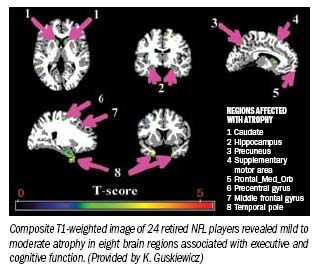MRI reveals sport-related brain damage
The brains of 24 retired National Football League players with known cognitive impairment show signs of damaging atrophy, according to advanced MRI studies described at the 2009 RSNA annual meeting.
The brains of 24 retired National Football League players with known cognitive impairment show signs of damaging atrophy, according to advanced MRI studies described at the 2009 RSNA annual meeting.
Songyuan Tang, Ph.D., a postdoctoral researcher associated with the University of North Carolina's Biomedical Research Imaging Center, presented preliminary imaging findings that represent the latest steps in research by principal investigator Kevin Guskiewicz, Ph.D., to study the relationship between football-related concussions and cognitive and behavioral problems that emerge long after the men's playing days are over.
The findings were drawn from on-going research conducted by Guskiewicz and colleagues at UNC's Center for the Study of Retired Athletes.
Guskiewicz first drew interest to football-related concussions and dementia in 2005 with a study suggesting that a history of three or more concussions was associated with an increased risk of cognitive impairment by age 50. An autopsy study, published by a different group in 2005, found concentrations of tau protein suggesting dementia in the brains of eight of nine former football players.
Guskiewicz and colleagues also published a study of 2552 retired pro football players in 2007. It revealed that retired NFL players with a history of three or more concussions also had a threefold increased risk of clinical depression after the age of 50 compared with age-matched controls.

Results from Guskiewicz's group presented at the RSNA meeting don't bode well for the 24 retired NFL players, all over age 50, who volunteered for an imaging trial involving structural MRI and diffusion tensor imaging (DTI), an advanced MRI technique that maps connections between neurons. The brain studies of the retired players were compared with identical studies performed on 12 cognitively normal men in the same age group. The retired players had an average of 12 years of combined NFL and collegiate football experience.
Based on T1-weighted imaging, researchers found diffused atrophies in the whole brains of the players. Mild to moderate gray matter atrophy was identified in eight brain regions of the former players.
In terms of white matter differences, fractional anisotropy DTI maps identified clusters of atrophy in five regions: the inferior frontal-occipital fasciculus, genu, sagittal stratum, posterior corona radiata, and splenium.
By applying fiber tractography to scans of one of the NFL subjects and a normal volunteer, researchers found a marked reduction in the number of fiber connections between neurons in the white matter of the left and right hemispheres of the former football player's brain. The affected regions included the genu, sagittal stratum, and splenium.
“Imaging addresses one piece of a larger puzzle, Guskiewicz said in an interview. “Along with the behavioral and psychological testing we're doing, imaging is helping us improve football safety.”
The Reading Room Podcast: Current Perspectives on the Updated Appropriate Use Criteria for Brain PET
March 18th 2025In a new podcast, Satoshi Minoshima, M.D., Ph.D., and James Williams, Ph.D., share their insights on the recently updated appropriate use criteria for amyloid PET and tau PET in patients with mild cognitive impairment.
Study with CT Data Suggests Women with PE Have More Than Triple the One-Year Mortality Rate than Men
April 3rd 2025After a multivariable assessment including age and comorbidities, women with pulmonary embolism (PE) had a 48 percent higher risk of one-year mortality than men with PE, according to a new study involving over 33,000 patients.
The Reading Room Podcast: Current Perspectives on the Updated Appropriate Use Criteria for Brain PET
March 18th 2025In a new podcast, Satoshi Minoshima, M.D., Ph.D., and James Williams, Ph.D., share their insights on the recently updated appropriate use criteria for amyloid PET and tau PET in patients with mild cognitive impairment.
Study with CT Data Suggests Women with PE Have More Than Triple the One-Year Mortality Rate than Men
April 3rd 2025After a multivariable assessment including age and comorbidities, women with pulmonary embolism (PE) had a 48 percent higher risk of one-year mortality than men with PE, according to a new study involving over 33,000 patients.
2 Commerce Drive
Cranbury, NJ 08512
All rights reserved.